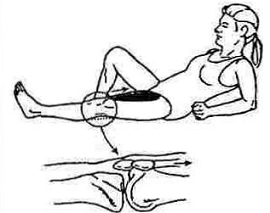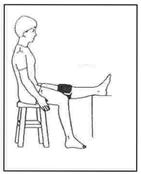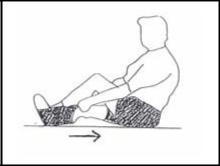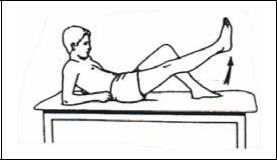Arthroscopic Knee Surgery
Diet
- Start with clear liquids (jello, soup broth, Gatorade, etc.), crackers, white bread and other light foods
- Progress slowly to heavier foods as you tolerate the lighter foods without any nausea
Wound Care
- Keep your dressing clean and dry and in place for two days after surgery.
- Do not submerge your leg under water
- On day 2 after surgery, you may remove your dressing. It is normal for there to be some blood staining on the dressings. If the wounds are completely dry, you may just place band-aids over them. If there is a small amount of drainage still coming from the wounds, place a clean and dry dressing on them daily until the drainage stops. If the drainage continues, call Dr. Roth’s office to inform him.
- Once you remove your dressing, you may shower. Let the water and soap run over the incisions and pat them dry with a clean towel after the shower. Do not scrub the incisions or vigorously dry them. Do not submerge the incisions under water (e.g. NO bath tubs, swimming pools, hot tubs, ocean swimming, etc.).
Medications
- You will usually have had some pain medicine injected into your knee during surgery which will last for 6-12 hours after surgery.
- You have been given a prescription for a narcotic pain medication (Percocet, Norco, etc.). Usually, people do need this medication for at least a few days after surgery. It is ok to switch to Tylenol or Advil or another NSAID as soon as you feel you are able.
- If your narcotic pain medication has ACETAMINOPHEN in it (e.g. Norco, Percocet) then you cannot at the same time also take TYLENOL, which is the same medication.
- Side effects of the pain medication include nausea, vomiting, dry mouth, constipation, dizziness and lightheadedness. Taking the medication with food will decrease the risk of nausea. For constipation, it is recommended that you take a stool softener while taking the narcotic. Colace can be purchased over the counter. Take one tab 2-3 times per day.
- If your stomach tolerates NSAIDS, you can take usually take these medications (e.g. Aleve, Advil, Motrin) along with your narcotic pain medication as they will not interact. An example of a nice pain regimen is included below. If you have questions, contact Dr. Roth’s office.
- Dr. Roth’s Suggested Post-Operative Pain Management Regimen (Percocet used as an example, but could be Norco or Percocet or other narcotic medication depending on what was prescribed by Dr. Roth)
- Do NOT drive a car or operate any heavy machinery while you are taking narcotic pain medication (Norco, Percocet, Tylenol #3, etc.)
Activity
- You will usually have had some pain medicine injected into your knee during surgery which will last for 6-12 hours after surgery.
- You have been given a prescription for a narcotic pain medication (Percocet, Norco, etc.). Usually, people do need this medication for at least a few days after surgery. It is ok to switch to Tylenol or Advil or another NSAID as soon as you feel you are able.
- If your narcotic pain medication has ACETAMINOPHEN in it (e.g. Norco, Percocet) then you cannot at the same time also take TYLENOL, which is the same medication.
- Side effects of the pain medication include nausea, vomiting, dry mouth, constipation, dizziness and lightheadedness. Taking the medication with food will decrease the risk of nausea. For constipation, it is recommended that you take a stool softener while taking the narcotic. Colace can be purchased over the counter. Take one tab 2-3 times per day.
- If your stomach tolerates NSAIDS, you can take usually take these medications (e.g. Aleve, Advil, Motrin) along with your narcotic pain medication as they will not interact. An example of a nice pain regimen is included below. If you have questions, contact Dr. Roth’s office.
Brace
- A brace is usually not necessary after your surgery.
ICE Therapy
- If you would like, you may purchase an ice machine from Dr. Roth’s office for the post-operative period as it is generally more convenient, however, usually ice packs are sufficient.
- Start ice immediately after surgery. You will have a bulky dressing on your knee and therefore you may not feel like the cold is penetrating, but it is still helping.
- Ice for 20 minutes a minimum of four times daily, or more often if you prefer, but no more often than 20 minutes every hour. Be sure there is always something between the ice pack and your skin and do NOT ice for longer than 20 minutes at a time or you could get frostbite.
- If you had a block at the time of surgery, your leg may be numb for up to 24 hours. It is particularly important during this time to be aware of the clock when you are icing as you will not feel the cold and frostbite is a real concern.
Exercise
- You may start your exercises 24 hours after surgery (described below).
- Try to do your exercises a minimum of 3 times per day after surgery.
- Your knee will feel painful and stiff after surgery which is normal, but it is appropriate and healthy to start trying to bend and straighten it (unless otherwise instructed by Dr. Roth)
- Your goal range of motion at your first post-operative visit is to be able to get the knee completely straight and to 90 degrees of flexion.
- Formal physical therapy will begin after your first post-operative visit.
- Do ankle pumps throughout the day to minimize the risk of blood clots.
Specific Exercises

Quadriceps Sets
Lie down or sit with your leg fully extended. Tighten and hold the muscle on the front of your thigh (“quad”) to make the knee flat and straight. Think about pushing the back of your knee down against the bed or floor. If you are doing it correctly, the knee will flatten and the kneecap will slide up toward the thigh muscle.

Heel Props
Lie on your back with your heel propped on a rolled towel or on the armrest of a couch. Or, sit in a chair with the heel propped on a chair. Leave nothing behind the back of your knee (e.g. no pillows behind your knee) and let the knee relax and become straighter. If you are unable to get the knee straight like this, you can place a weight (2 to 5 lbs.) on the thigh, just above the kneecap, to help push the knee straight. Patients often worry about “hyperextending” the knee, but this does not need to be worried about as long as you are not using more than 5 lbs. of weight.

Prone Heel Hangs
Lie on your stomach on a raised surface such as a table or a bed, and slide down so that your knee at the edge of the table and your foot is off the edge. Let the knee relax and let gravity pull your knee straight. As in the Heel Props above, if you cannot get the knee straight, a light weight (2 to 5 lbs.) can be hung from your heel to help add to the pull of gravity.

Heel Slides
While sitting or lying on the floor or a bed, gently try to slide your heel along the floor toward your thigh by bending your knee. Hold this for a few seconds, and then slowly straighten the knee back out. If you have trouble doing this, you can take a towel and wrap it around the ball of your foot and use your hands to help gently pull your knee into flexion.

Straight Leg Raises
If your knee bends when you are doing this exercise, you are not yet ready. Continue working on the QUADRICEPS SETS (described above) until you are able to do this exercise keeping the knee completely straight
The Straight Leg Raise is all about focusing on tightening your quadriceps muscle, which is why you have to be good at the Quad Set before you can be good at the Straight Leg Raise
- The steps of a good Straight Leg Raise are as follows:
- Tighten the quadriceps as much as you can (same as a quad set)
- Tighten it even harder!
- Lift your heel 4 to 6 inches off the floor, keeping the knee straight
- Think about tightening your quad even harder!
- Lower the leg gently back to the floor, keeping the quad as tight as possible
- Try one more time to tighten the quadriceps muscle
- Now relax and rest a minute or two, and repeat

Ankle Pumps
Move your foot up and down like you are stepping on and off of a gas pedal. This helps circulate blood through your leg. Do this about 20-30 times, every few hours.
Emergencies
- During business hours, contact Sabrina in Dr. Roth’s office at 510-267-4013. If you are not getting through to Sabrina because she is busy in the office and not able to immediately answer the phone, contact 800-943-8099 and they will track down Dr. Roth.
- For concerns that cannot be addressed during business hours, call
800-943-8099.
- For the first 48 hours after surgery, the call center will put you through directly to Dr. Roth’s cell phone if you would like. Dr. Roth feels that it is very important that you have the opportunity to speak directly to your surgeon rather than to an “on-call” physician within the first 48 hours after surgery if you have concerns. Because Dr. Roth is typically at home with his family during these times, he would appreciate the use of discretion when taking advantage of this service. If you feel you have a simple question that you would be comfortable with the on-call physician handling, please inform the call center.
- Please contact Dr. Roth’s office immediately if any of the following are present, or for any other concerns:
- Pain that is not controlled by the regimen described above
- Pain that is unrelenting or getting worse over time rather than staying the same or improving
- Numbness that lasts longer than 24 hours after surgery
- Fever (greater than 101⁰ - low grade fever is normal for the first few days after surgery)
- Redness around the incisions
- Continuous drainage or bleeding from the incision (some drainage is expected)
- Difficulty breathing
- Chest Pain
- Light headedness or passing out o Uncontrollable nausea, vomiting
- Color change in the operative extremity o Blistering of the skin
- If you have an emergency that requires immediate attention, proceed to the nearest Emergency Room.
Follow-UP
- If you do not already have a follow-up appointment scheduled, please contact Dorothy at (510) 267-4016 to arrange an appointment. Follow-up appointments are generally 7-10 days after surgery.











